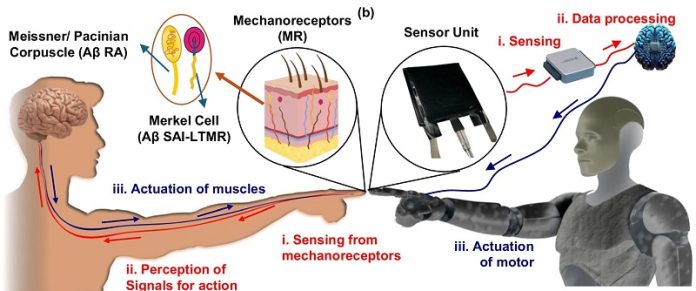
Robots are great at many tasks, from assembling machines to assisting in surgery.
But when it comes to something humans do effortlessly—like picking up a fragile item without breaking it—they often struggle.
Either the robot grips too softly and drops it, or too hard and crushes it. The reason? Robots haven’t had a good sense of touch—until now.
Scientists at the University at Buffalo (UB) have developed a new kind of electronic fabric that could give robots a much more human-like sense of touch.
This breakthrough technology, described in a study published July 30 in Nature Communications, allows robots to detect not only pressure, but also slipping and movement—just like human skin.
“This is really exciting because it could help robots work better with people,” said Jun Liu, the lead researcher and an assistant professor in UB’s Department of Mechanical and Aerospace Engineering.
“It could be used in factories where humans and robots work together, in robotic surgery, or even in prosthetic limbs.”
Liu worked on the project with Ehsan Esfahani, another professor at UB, along with several students and collaborators.
Together, they created a flexible, highly sensitive sensor made from electronic fabric—also known as e-textile. When sewn into robotic fingers, this fabric can sense when something is slipping and quickly adjust grip strength.
The secret behind this smart fabric is something called the tribovoltaic effect. When two materials rub against each other, they generate electricity. This tiny burst of electricity is what tells the robot that something has moved or started to slip.
And the best part? The sensor is fast—really fast. Depending on the situation, it can respond in just 0.76 to 38 milliseconds. For comparison, human touch sensors typically respond in 1 to 50 milliseconds.
To test their new technology, the team built a robotic hand with 3D-printed fingers and added the fabric sensor. When they tried to pull a small weight out of the robot’s grasp, the robot instantly felt it and tightened its grip—just like a human would.
Vashin Gautham, a Ph.D. student who helped lead the research, said, “It’s like giving robots a real sense of touch and grip. This could change how they interact with the world.” With this new level of control, robots might soon be able to handle delicate tasks that were once impossible, like safely holding a raw egg or helping in surgery with incredible precision.
The research team is already planning the next step: combining the touch-sensitive fabric with artificial intelligence. This would allow robots to learn from experience and improve how they handle objects, much like humans do.
Ultimately, this innovation could lead to safer, smarter, and more capable robots that can work side by side with people—or even help those who have lost the use of a limb.
By giving machines a better sense of touch, scientists are bringing us closer to a future where robots are more helpful and human than ever before.



